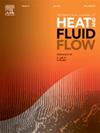Visual experimental study on flat-plate pulsating heat pipe with double condensers
IF 2.6
3区 工程技术
Q2 ENGINEERING, MECHANICAL
International Journal of Heat and Fluid Flow
Pub Date : 2025-04-01
DOI:10.1016/j.ijheatfluidflow.2025.109831
引用次数: 0
Abstract
In the present study, a visual experiment is performed to investigate the thermo-hydrodynamic characteristics of the flat-plate pulsating heat pipes (FPPHP) with double condensers. The operating performance of a FPPHP with double condensers is compared to that of a typical FPPHP with a single condenser. The results indicate that the FPPHP with double condensers exhibits higher imbalance pressure difference between its condensers and evaporator, leading to an enhanced oscillation frequency of the internal gas–liquid plug, which expands the working range of this FPPHP and at the same time significantly reduces thermal resistance. With power inputs ranging from 60 W to 720 W, its thermal resistance ranges from 0.12 K/W to 0.04 K/W, a decrease of 12 % to 46.9 % compared to that with a single condenser. The mechanism of the influences of temperature of the condensing side and length ratio of the two condensers on the operating performance of the FPPHP with double condensers is studied. The experimental results show that the FPPHP with symmetrical double condensers (i.e., in equal cooling areas) has better temperature uniformity and wider operating range than that with asymmetric double condensers in the same cooling areas. Hence, this research has important implications for the design of high-power electronics cooling and thermal management in confined spaces.
求助全文
约1分钟内获得全文
求助全文
来源期刊

International Journal of Heat and Fluid Flow
工程技术-工程:机械
CiteScore
5.00
自引率
7.70%
发文量
131
审稿时长
33 days
期刊介绍:
The International Journal of Heat and Fluid Flow welcomes high-quality original contributions on experimental, computational, and physical aspects of convective heat transfer and fluid dynamics relevant to engineering or the environment, including multiphase and microscale flows.
Papers reporting the application of these disciplines to design and development, with emphasis on new technological fields, are also welcomed. Some of these new fields include microscale electronic and mechanical systems; medical and biological systems; and thermal and flow control in both the internal and external environment.
 求助内容:
求助内容: 应助结果提醒方式:
应助结果提醒方式:


